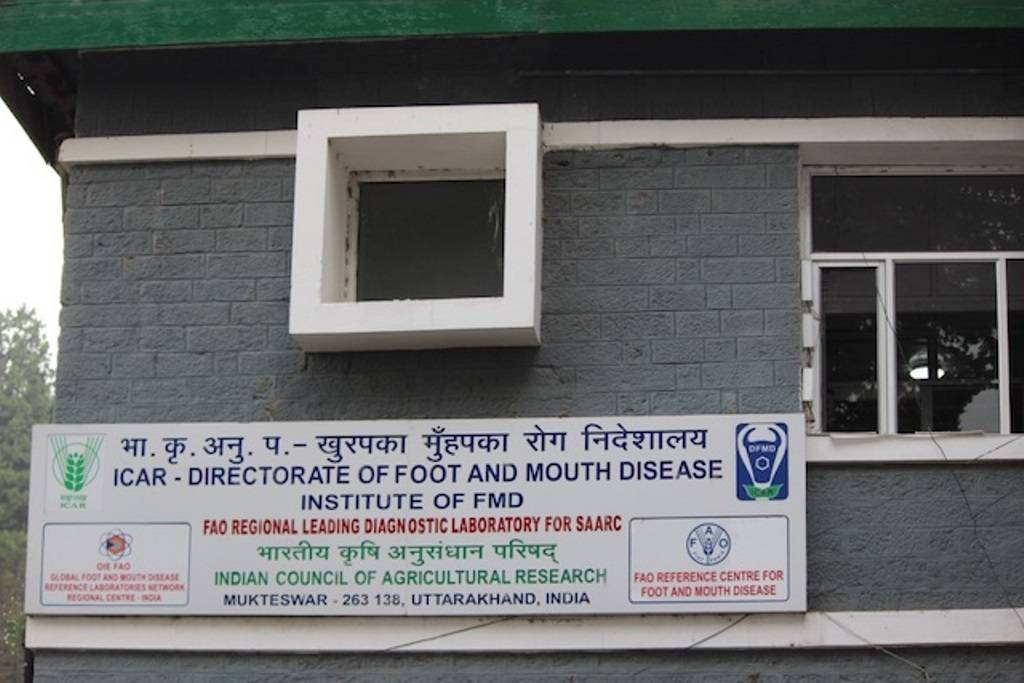
Raveling about 63 km on the zig-zag roads of Kumaoun Himalayan range, the Krishi Jagran team reached the beautiful landscape of Mukteshwar from Kathgodam station. Situated at a splendid location in Mukteshwar at the height of 7,000+ ft. above sea level the directorate of Food and mouth diseases has taken space inside the IVRI-Mukteshwar campus, which is one of the few developments made by the Britishers in this heat-respite zone.
To understand the importance of this institution in treating the disease, it is imperative to understand its severity of it. FMD, Food, and Mouth Disease are some of the most common ailments in the dairy sector and yet are prevalent after 40 years of the continuous vaccination program and still slap the economy since treatment for FMD are not possible.
Dr. B. Pattnaik, Director Head, FAO-RLDL, South Asia educates, “FMD is a highly contagious viral disease which is transboundary in nature, thanks to the fast spread/transmission of the virus, this one particular disease has a severe negative impact on country’s economy and food security. The virus primarily affects cattle, buffalo, and pigs, though sheep, goats,s and several species of wildlife are also susceptible to the disease.”
Though the death rate is not much in the bovines, the affected animals undergo an 80% drop in milk production also loses power and stamina. Annual direct loss on account of FMD in India alone is estimated to be Rs. 23,000 Cr.
“What polio is for humans, is FMD for cattle,” mentions Dr. Sagar, who is a scientist at the ICAR-DFMD, Mukteshwar. “
HISTORY
There are 7 antigenically distinct serotypes of FMDV, such as O, A, C, Asia1, and SAT1-3, which are prevalent all over the world. In India, 4 serotypes O, A, C, and Asia1 have been recorded to be affecting the most.
Epidemiological studies on FMD in India were initiated in the form of an “All India Coordinated Research Project ( AICRP) for virus typing” in 1968 with a central laboratory in Mukteshwar and 3 regional centers.

During the last 11 years, a total of 4305 FMD incidences/cases were diagnosed in India. The highest incidence was observed during 2007-08, while the lowest was during 2014-15. The eastern region recorded maximum proportions of 36.1% of the total incidences followed by 32.1% in the southern region while North Eastern recorded 14.3% of the total incidence, and it was lower 4.08% in Northern India, while the numbers stood at 6.1% in western and 6.4% in the central region.
In the last 10 years, the maximum incidence was recorded during the months of January to March and October to December. Usually, incidences of FMD start to occur from August and reach their peak in November and maintain until January.
Importance of ICAR-Directorate FMD in handling the disease:
Real-time monitoring (RTM) is essential to genomic diversity in circulating FMD virus strains. RTM is essential to maintain preparedness in time to handle mutations leading to antigenic alteration/change compared to vaccine candidate strains.
The institute has been developing and using tools to identify carrier animals in vaccinated populations. Dr. Sagar mentions,” Developing vaccines for FMD is a continuous process, since being an RNS transmitted diseases the genotype of the diseases keeps on changing which had to comply with the health of the cattle and activity of the virus.
The institute plays a direct role in the FMD control program by providing
i) companion diagnostics for the program
ii) post-vaccination sero-monitoring service.
Both active and passive surveillance by the institute has helped in assessing the efficacy of the FMDCP. Required laboratory and specialized scientific manpower back up to the program are provided by the institute. Biannual vaccination, based on FMD Control Programme (FMD-CP) has been initiated by the Government of India since August 2003-04 initially covering 54 specific districts in the country.
Investigation and analysis by the institute have revealed a progressive increase in herd immunity and a decline in DIVA positivity that indicated a positive impact of vaccination for the last 10-12 years. No disease control program can be successful without companion diagnostics. ICAR-DFMD provides two important companion diagnostics for application in FMDCP:
i) DIVA-ELISA kits and
ii) Blocking ELISA.
The new addition to the Directorate is the International Centre for Foot and Mouth which has been set up in Aragul, Odisha. A prestigious R&D facility of ICAR with BSL3+ laboratory & Animal Experiment Facility for conducting biomedical research in the area of Foot and Mouth. This facility shall also serve as a regional resource Laboratory for SAARC countries.
FARMERS Momentous Role in keeping the disease at bay:
Farmers play a huge role in controlling the disease. Since treatment in FMD is not possible, vaccination is the only solution. Every farmer has to be educated about the importance of vaccination. Timely vaccination and proper quarantine are a few of the measure that is to be followed religiously. There are myths about dropping milk production in dairy animals after vaccination, but that is due to body stimulus to the foreign entry in the animal’s body. The effects are limited to a maximum 20% decrease in milk production which goes back to being normal after 10 days.
Proper extension services are to be laid on the ground so that farmers are aware of the symptoms and are well equipped to take care of the situation. Keeping the affected animals away from the other herd would save the farmer’s investment in dairy and would also strengthen his financials.
61 countries and 21 zones in the world are officially recognized to be FMD free by the OIE (World Organisation for Animal Health). Brazil is the new entry in this sequence, which has been accolade to be the country which is FMD free, with complete vaccination. India is on the right path and can get in the list of FMD free countries if the program and promotion of the vaccination drives are done timely.















